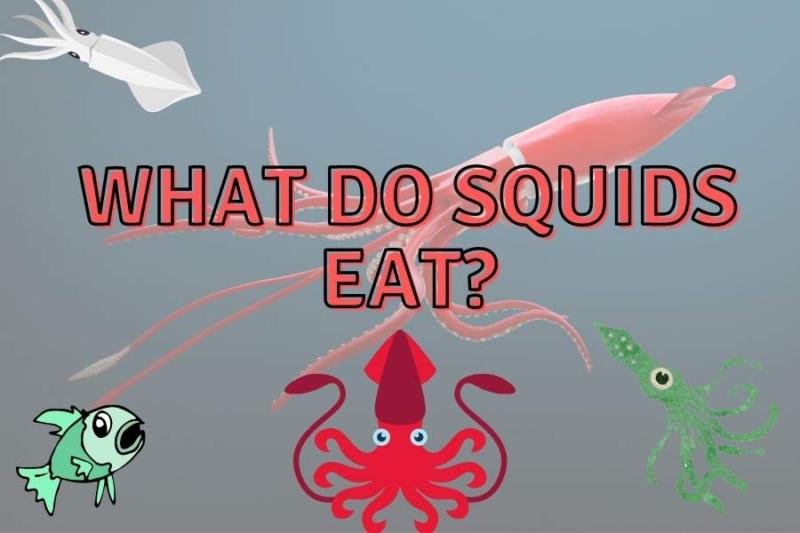Squids are probably some of the most fascinating sea creatures on Earth. Squids are a group of marine cephalopod mollusks that are closely related to octopuses and cuttlefish.
Some squids are (almost) on top of the food chain can get very large such as the legendary colossal squid, which has a length of up to 10 meters (33 feet) weighing up to around 700kg (1500 lbs)!
The exact diet varies between squids, depending on their habitat, size, and time of year. I have included specific examples of squid diets of different species later in this article.
Collectively, the most common dietary items of squids are:
- Fish (like codfish, mackerels, numerous deep sea fish etc.)
- Other squids (usually smaller than themselves)
- Amphipods
- Shrimp
- Crabs
- Lobsters
- Krill
- Octopuses
- Clams
- Mussels
If you are interested in any particular food item or what type of squid eat most of each prey listed here, scroll on to read more or jump using the table of content below.
Contents
What do squid eat?
Squids, those fascinating creatures of the ocean depths, exhibit a diverse range of feeding strategies that reflect their adaptability to different habitats and ecological niches. As a biologist who has delved into the enigmatic world of squids, I can attest to the intricate interplay between these cephalopods and their preferred prey items.
Fish hold a significant place on the squid menu, as they provide a rich source of sustenance. Various squid species demonstrate a penchant for piscine fare, such as the giant squid (Architeuthis dux) and the Humboldt squid (Dosidicus gigas).
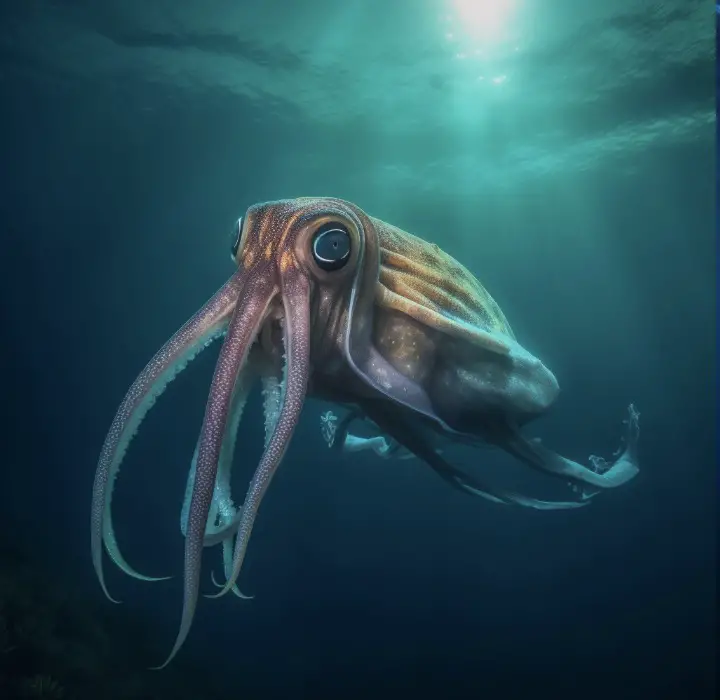
The giant squid, known for its colossal size and legendary status, has been reported to devour fish such as codfish and mackerel. On the other hand, the Humboldt squid, a formidable predator in its own right, has been observed to engage in frenzied feeding frenzies, targeting numerous deep-sea fish species as part of its diet.
Interestingly, squids are not averse to turning to their own kind for sustenance. Cannibalism, though not universally observed, is not an uncommon phenomenon among these cephalopods.
Smaller species of squid often fall prey to their larger counterparts, a practice witnessed in species like the European common squid (Loligo vulgaris) and the Japanese flying squid (Todarodes pacificus). These voracious hunters exhibit an appetite for squid of smaller size, thereby reinforcing the adage of “survival of the fittest” within their underwater realm.
Venturing beyond fish and fellow squids, amphipods find themselves on the menu of certain squid species. These small, shrimp-like crustaceans often serve as a delectable feast for the likes of the glass squid (Teuthowenia pellucida), which navigates the depths of the ocean in search of these tiny morsels. The glass squid, with its transparent body, can camouflage itself effectively, enabling it to sneak up on unsuspecting amphipods with ease.
Speaking of shrimp, it comes as no surprise that they form an integral part of the squid diet. Various species of shrimp, such as the ubiquitous krill, are devoured by squids across different marine ecosystems. The arrow squid (Nototodarus gouldi), for instance, has been documented as a predator of krill, showcasing the versatility of squid feeding habits.
The taste for crustaceans extends beyond shrimp to include crabs and lobsters. While larger squids like the colossal squid, as its name suggests, primarily hunt deep-sea fish, smaller species like the market squid (Loligo opalescens) have been observed to seize opportunities to feast upon these delectable crustaceans.
As we delve into the varied diet of squids, it becomes evident that they do not discriminate against other cephalopods. Octopuses, those intelligent and elusive creatures, have found themselves at the mercy of larger squids.
For instance, the giant squid, in its colossal dominance, has been known to engage in epic battles with octopuses, and in some cases, claim them as a valuable food source.
Among the bivalves that find themselves preyed upon by squids are clams and mussels. These mollusks, though seemingly immobile, are not immune to the stealthy advances of certain squid species. For instance, the swordtip squid (Uroteuthis edulis) has been observed to feed on clams, showcasing the ability of squids to capitalize on available food resources.
When it comes to understanding the feeding habits of squids, we must also consider the influence of environmental factors and seasonal variations. Squids are known to exhibit dynamic foraging behaviors based on the abundance and availability of their prey items.
For instance, during certain times of the year, large swarms of krill and zooplankton may migrate to specific areas, attracting squids in search of an abundant food source. This phenomenon can be observed in species like the firefly squid (Watasenia scintillans), which congregates in large numbers off the coast of Japan during the springtime to feed on these tiny organisms.
It is important to note that the diet of squids can vary not only between species but also within individual squids themselves. As they grow and develop, their feeding preferences may change, reflecting their evolving nutritional needs.
For instance, juvenile squids may predominantly consume small crustaceans and zooplankton to support their rapid growth, while adult squids may shift towards larger prey items like fish and cephalopods to sustain their energy requirements.
Furthermore, the feeding strategies employed by squids can be influenced by their unique anatomical adaptations.
Squids possess a remarkable feeding apparatus known as the beak, which is composed of chitinous material and serves as a formidable tool for capturing and devouring prey. With this beak, squids are capable of tearing through the exoskeletons of crustaceans, crushing the shells of mollusks, and gripping onto slippery fish with precision and efficiency.
In summary, the dietary preferences of squids encompass a wide array of marine organisms, including fish, other squids, amphipods, shrimp, crabs, lobsters, krill, octopuses, clams, and mussels.
Each species of squid exhibits its own unique feeding habits, adapting to its habitat, size, and seasonal variations in prey availability. As a biologist who has marveled at the intricate dynamics of these fascinating creatures, I continue to be captivated by their ability to navigate the vast depths of the ocean and secure their place in the ever-competitive realm of the underwater food chain.
How do squids eat?
We already know that squids are predators and that most of their diet consists of living animals.
They are mostly night-active (nocturnal) animals that hunt for prey in the ocean and squids are extremely quiet when they hunt, which allows them to sneak onto their prey.
Squids do not have very good hearing, although they, just like octopuses, can detect vibrations in the water.
In contrast, squid relies predominantly on their large and effective eyes to spot prey and attackers way before they spot the squid. They may also use visual tricks such as ink or the changing color of their skin to confuse their prey.
Some squids living in the darkness of the deep sea, like the Dana octopus squid, use a spectacular array of lights on its eight tentacles to confuse and overwhelm their prey.
Once they’ve locked on their prey, they swiftly reach out and catch their prey tightly with their two longest tentacles. These tentacles have very sharp rings and strong suctions resulting in a firm grip.
The remaining eight arms are used to hold onto the newly caught prey and bring it into the mouth of the squid, where the squid uses its venomous saliva to paralyze its prey.
When the prey has been caught, squids use their tough beaks (resembling that of a large parrot) to kill it and shred it into small consumable pieces. Inside the squid’s mouth lies the radula which is a sharp tongue-like organ that helps the squid break down its food further.
Like octopuses, squids do not have teeth, but the radula has small teeth that help them extract and process food.
Like in other mollusks, the radula of squid is, similar to that of octopuses, covered in teeth-like structures that are used to “chew” their food apart.
What does the Giant Squid eat?
The giant squid is perhaps the most common of the larger squids, with the female weighing around 250kg (550lbs).
It resides in the deep sea at about 2500 feet, but may dive as deep as 7000 feet! They are most often sighted in the Atlantic and the North Pacific seas near South Africa and New Zealand.
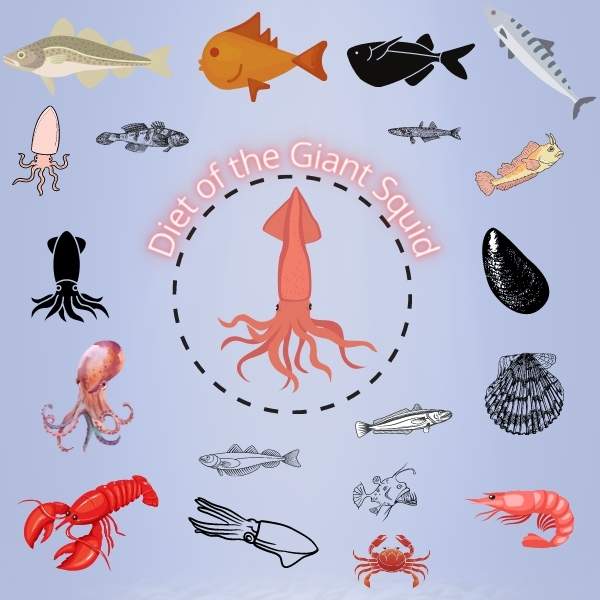
The giant squid feeds mostly on fish of the deep sea, but also extensively on other squids, octopuses, lobsters, clams, and mussels.
Can large squids eat people?
In theory, giant squids can eat people but it is very unlikely. There are no reliable shreds of evidence that squids have eaten people, or even other primates like any type of monkeys, in the past.
Squids would probably be more afraid of humans and they have indeed evolved numerous techniques to evade their predators!
However, squid attacks on people have been a concern, or at least a topic of old folk and seafarer tales, for centuries now!
Even the most vicious of giant squids will have few opportunities to eat humans because they live in the deep ocean, and never come to the ocean surface near humans unless they are sick.
However, the Humboldt squid lives somewhat closer to the surface and is more likely to encounter humans.
The Humboldt squids (also known as the Dumbo squid due to their ear-like structures) are aggressive by nature have caused several attacks against humans, especially deep-sea scuba divers.
Many believe that they attack due to their unfamiliarity with the divers. They are considered dangerous and can cause fatal wounds to their victims.
After being caught they continue to display aggressive behaviors and spray water and ink. Despite this, there are no reported incidents of them actually eating people.
If a giant squid ever encounters a human being, it is likely that it is sick and has less chance of attacking. It is also more likely that the giant squid would be attacked by one of its natural predators before even reaching the surface!
The only opportunity for a giant squid to eat a human being is when a dead human body sunk hundreds of meters under the ocean.
What do smaller squids eat?
While the giant squid is one of the most fascinating squids, the vast majority of squids, like the Argentine Shortfin Squid and the Caribbean Reef Squid are smaller, which places them somewhat lower in the food chain and restricts them to smaller, less hostile, food items.
The Argentine Shortfin Squid is one of the most popular squids for human consumption. It is the most fished for squid and it resides in large numbers near the coasts of Argentina and Brazil.
Contrary to the giant squid, the Argentine Shortfin Squid is a small squid species that measures only one foot in length (30 cm), so it makes a good example of the diet consumed by a smaller squid species.
The Caribbean Reef Squid is even smaller at only half a foot (15cm) in length and resides near the coasts of central and South America, especially the sea surrounding Florida, the Caribbean, and Bermuda.
The Caribbean Reef Squid is interesting in the sense that it hunts not only at night, or in the dark, as most other squid but also in the daylight in shallow waters.
Like other squids, the Caribbean Reef Squids often hunt in packs during the day, but mostly alone during the night. They have a sophisticated hunting tactic, involving light reflections and color shifting to confuse and attract prey.
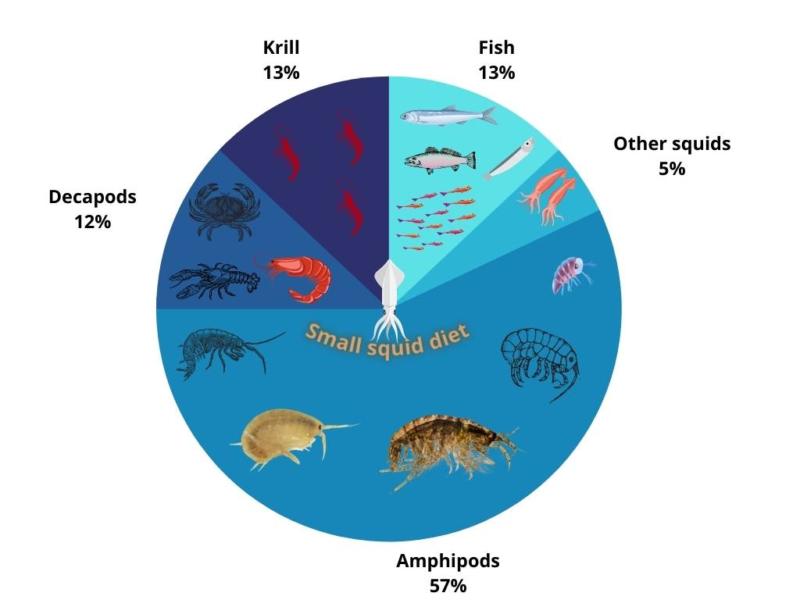
The high-level diets of smaller squid like the Argentine Shortfin Squid and the Caribbean Reef Squid are quite similar, consisting mostly of smaller crustaceans the majority of which are amphipods.
Being small, these squid not only have less food options, but they also are prey for larger animals themselves!
Do squids eat crabs?
Yes, but not all kinds of crabs. Squids don’t live on the seafloor like most marine crabs. Squids live in the open water so they can only prey on active crabs that travel to the open water like the Pelagic Red Crab. They are squid favorites and are accessible prey to squids like the Dumbo squid.
To answer your question directly, yes, some squids do indeed eat crabs. However, it is important to note that not all squid species have the same dietary preferences, and their feeding habits can vary significantly depending on their size, habitat, and ecological niche. Let’s explore this fascinating interaction further, shall we?
Firstly, let’s consider the dietary habits of squids. Squids are known as voracious predators, occupying various niches in the marine ecosystem. Their diets often consist of a diverse range of prey items, including small fish, shrimp, krill, and of course, crabs. The specific squid species that feed on crabs can vary, but examples include the common market squid (Doryteuthis opalescens), the giant squid (Architeuthis dux), and the Humboldt squid (Dosidicus gigas).
When it comes to crabs, they are a highly abundant and diverse group of crustaceans found in various marine habitats. Crabs exhibit a wide range of adaptations and behaviors, and their availability as prey can attract different squid species. Some crabs are more vulnerable to predation due to their slower movements or lack of defensive adaptations, while others may be well-equipped to evade squid predation through camouflage or defensive mechanisms such as strong claws or spines.
Drawing from my personal experiences as a biologist conducting field research, I have had the opportunity to observe squids hunting and feeding on crabs in their natural habitat. The process is truly captivating to witness! Squids have a remarkable ability to locate and capture their prey using a combination of visual cues and specialized sensory organs. They possess large, keen eyes that allow them to spot potential prey items, including crabs, from a considerable distance. Once a squid detects a crab, it will swiftly initiate a pursuit.
The hunting strategies employed by squids can vary depending on the species and the behavior of their prey. Some squids, like the Humboldt squid, are known for their aggressive and active hunting behavior. They often form large shoals and engage in cooperative hunting, which can make them formidable predators for crabs. These squids employ a combination of speed, agility, and coordinated movements to surround and capture their prey.
On the other hand, certain squid species, like the market squid, may employ a more stealthy approach when targeting crabs. These squids have the ability to change the color and pattern of their skin, allowing them to blend seamlessly with their surroundings. This camouflage enables them to approach their prey undetected before launching a swift and precise attack.
As for the timing of squid predation on crabs, it can vary depending on factors such as seasonality, prey availability, and the squid’s life stage. Some squids, particularly those that migrate, may exhibit feeding patterns that align with the seasonal abundance of crabs. For example, during certain times of the year when crabs are more abundant, squids may adjust their feeding behavior to take advantage of this prey source.
Additionally, it is worth noting that the dietary preferences of squids can change as they grow and develop. Young squids often have different feeding habits compared to adults. They may consume smaller prey items such as krill or small crustaceans before transitioning to larger prey like crabs as they mature. This shift in diet can be influenced by changes in the squid’s size, physiology, and hunting capabilities.
In conclusion, while not all squids eat crabs, some species do indeed include crabs as part of their diet.
Where are squids in the food chain?
Squids fall into the category of predators in the ocean food chain. They are mainly tertiary consumers making them capable of eating both herbivores and carnivores prey.
Their diet mainly includes fish, crustaceans, and other squids. When food is scarce, they even prey on their own species and fight each other for other food sources.
Squids are mostly carnivorous cephalopods that range from a few inches to 33 feet, which is why some squids are capable of eating larger animals; placing them high up in the food chain, but the exact position is determined by their size and weight.
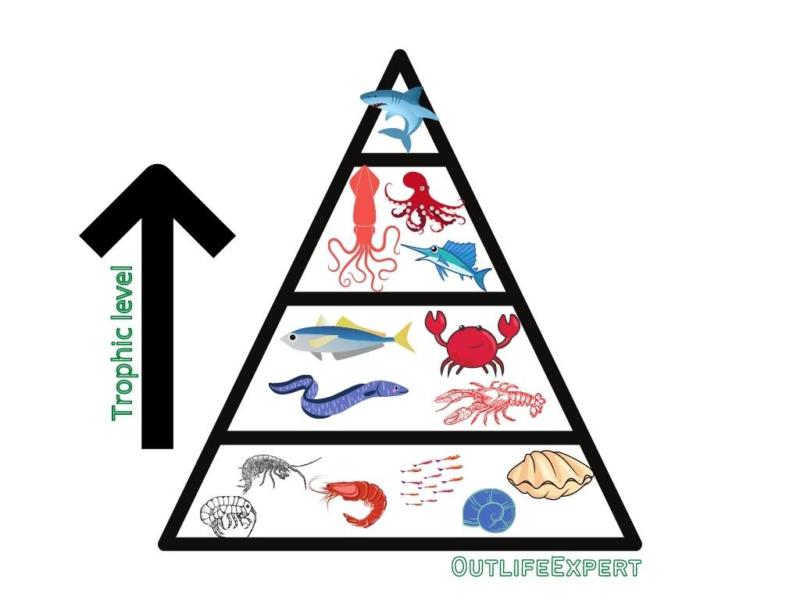
The Giant and Colossal squids are the most predacious squid species. They are two of the largest living invertebrates on the Earth capable of eating a wide range of fish, crustaceans as well as nearly all other squids and octopuses.
It is not surprising that these huge soft-bodied creatures continue to dominate the ocean food chain, given their highly evolved nature and fairly undisturbed habitat of the deep sea have rendered them as one of the top predators of their realm.
Even though larger squids are superior predators, they also serve as prey to larger predators such as sharks and sperm whales.
Small squids are also classified as predators but unlike Giant and Colossal squids, they serve as prey for a large number of animals like fish, sharks, whales, and even birds and humans.
However, squid have developed numerous fascinating techniques to avoid predators!
Not all squids are predators though.
Another interesting squid species that many ocean enthusiasts like to tackle is the vampire squid and its relatedness to other squids.
Contrary to its name, vampire squids don’t actually belong to the squid species – and it certainly does not suck blood or attack other animals!
In fact, the vampire squid is a unique animal species that scientists classified into its own group that is closer related to octopi than other squids.
When disturbed, it inverts its cape and displays its large spines but this intimidating pose is fairly harmless. The vampire squid is not a predatory animal and depends on planktonic particles that get trapped in its tentacles.
Squid diet FAQs
If you are interested in specific items that squids might eat, I have made a list of the most frequently asked questions regarding food items of squids.
Do squid eat fish?
YES! The bulk of most squid’s diets is fish. The type of fish that each squid eats depends on its size and habitat of the squid. The Giant Squid eats mostly cod-like fish and deep-sea fish, but also smaller fish like whiting, mackerel, gobies, silversides, and numerous deep-sea fish such as roughies and redfish.
Can a squid eat sharks?
There are no reports of squids that eat sharks however squid and shark encounters have been observed over the years. In an article from Forbes, it was stated that white sharks were detected to have incurred unusual scars.
After being examined, the scars were revealed to have been potentially caused by the Jumbo squid, Neon Flying squid, or the Giant squid.
Giant squids are strong enough to attack sharks and hang on them with their suction cups. This can cause the shark to incur fatal damages like losing a fin which can eventually lead them to lose blood or drown.
However, a much more likely outcome is that the squid is eaten by the shark instead!
Do Squids Eat Seaweed?
No, squids do not eat seaweeds because they are mainly carnivorous. They may unintentionally ingest seaweed through the fish, crustaceans that they eat.
But despite being one of the top predators in the ocean they do not eat seaweeds but instead use it as a nesting ground for their eggs and some even use it as a strategic location to ambush their potential prey which is commonly small fishes and crabs.
Squids no matter their size and weight are all strictly carnivores, they do not eat seagrass or seaweed and they prefer to eat meat especially the giant squid who believe can grow up to 46 inches and can eat a small human.
Can a squid eat a whale?
If you have been fascinated by how big some squids are, then you have probably had the idea of giant squids eating whales or other large sea creatures.
Generally, whales are bigger than even the biggest squids (the giant squid being 12m and a small whale shark being 18m), which would make it unlikely that a squid could eat it.
I have found no record of squids that eat whales. On the contrary, some whales like the sperm whale eat a substantial amount of squid.
Furthermore, the largest squid, the colossal squid are very large creatures that live in the deeper parts of the sea, where most whales don’t go.
Do squid eat other squid?
Yes! Like many other sea creatures, cannibalism is common among squids.
And not only do they eat other species of squid, but they also gladly eat members of their own species! This cannibalism is thought to be motivated partly by competition for territory, mates, but especially food.
In fact, for squids like the Humboldt squid, other Humboldt squids make up 26% of its diet, and the further 10% are made up of other squids and octopuses.
Do squids eat birds?
It is not impossible that a giant squid could eat a bird like a seagull that has died and sunk to the bottom of the sea. But because most squids live far under the surface, they are not near the sea surface to catch birds.
Do squid eat cuttlefish?
Squid and cuttlefish are often confused, but they are not the same. Indeed they look very similar and belong to the group of Cephalopods just as octopuses and squids.
A major part of most squid diets is other Cephalopod s– including cuttlefish and other smaller squids!
Cuttlefish are usually smaller than squid and it is, therefore, most often cuttlefish that is consumed by squid rather than the other way around.
Do squids eat their own arms?
As squid predators are often other squids, they may each other’s arms, but not their own.
Some octopuses are known to eat their own arms when stressed, but this phenomenon is not observed in squid.
However, squid can perform autotomy like crabs and lizards, where they purposefully lose their arms to escape predators. And just like crabs, lobsters and lizards, they can also easily grow back their own arms.
Do squid eat copepods?
Yes, smaller squids will eat small crustaceans such as copepods and other zooplankton. In fact, copepods make up around 85% of the minimal armhook squids diet.
And even larger squid may eat small crustaceans such as krill, which eat a large number of copepods.
Do squid eat clownfish?
Squids are large enough to eat clownfish and the clownfish do not normally share habitat.
Clownfish live in tropical waters of the red sea in shallow waters near anemones. Larger squids rarely go to shallow waters and would therefore not be likely to encounter and eat clownfish in the wild.
In theory, the Argentine Shortfin Squid could probably eat a clownfish if kept together in a saltwater reef tank.
Do squid eat anchovies?
Anchovies are small fish that normally keep above 50m (165 feet) of sea depth and will therefore be unlikely to encounter larger squids.
Do squid eat plankton?
Yes, smaller squids eat a significant proportion of their diet as zooplankton such as copepods. Plankton makes up more than 90% of the minimal armhook squids diet.
Do squid eat algae?
Not on purpose. Although squid are carnivores and algae are defined as microscopic plants and bacteria, they cannot fully control which microscopic particles enter their mouth and they may therefore ingest algae accidentally to some extent.
Do squids eat sperm whales?
No. The sperm whale is the most feared predator of even the giant and colossal squids!
Do squid eat coral?
No, even though corals are animals, they are not included in the squid diet. This means that squid are completely reef safe.
Do squid eat krill?
Yes! A major part of many squids’ diets consists of krill and other smaller crustaceans.
Do squid eat crayfish?
Because squids are saltwater animals, they do not normally encounter crayfish, however, as squid eat lobsters, they would likely also eat crayfish if given the chance.
Do squids eat goldfish?
Squid and goldfish do not normally share a habitat, but most squid would be able to consume goldfish, yes.
Do squids eat sharks?
While octopuses are sometimes able to overpower smaller sharks, I have found no evidence of squids eating sharks.
Do squid eat cod?
Yes, cod and similar-sized fish make up a substantial part of the giant squid diet.
Do squids eat meat?
Squid are carnivorous, so most of what they eat is the meat of animals.
Do squid eat animals?
Yes! Most squids eat nothing else. They live entirely from other marine animals.
Do squid eat ducks?
No. Ducks are also mostly found near freshwater and squids live exclusively in saltwater.
It is not impossible that a giant squid could eat a bird like a duck that has died and sunk to the bottom of the sea. But because large squids live far under the surface, they are not near the sea surface to catch birds.
Do squid eat clams?
Yes, just like octopuses, squid can manipulate the shells of clams and mussels open with their arms, beak, and spiked radula.
Do squid eat Dogs?
No, don’t be silly. Dogs are not found in the deep sea, are they?
Do squid eat seagrass?
No, squids are strictly carnivorous.
Do squid eat shrimp?
Yes, nearly all squids eat shrimps or other smaller crustaceans.
Do squid eat abalone?
In theory yes, giant squids eat clams and mussels, but abalones are often found in shallow (<90 feet) whereas the squids eating clams are found in much deeper waters (>1000 feet).
Do squid eat herring?
While herring is mostly found in the upper sea depths and in colder waters, even smaller squids eat many herring-sized fish and could easily eat herring if they encounter them.
Do squids eat sea sponges?
Squid normally prefer moving animals and are not known to eat sponges.
Do squid eat parrotfish?
Larger squid could eat parrotfish. However, they do not often share the same habitat as parrotfish live in shallow waters.
Do squid eat eels?
Yes, if encountered, a squid could eat an eel.
Do squids eat orcas?
No, like whales and sharks, orcas, also known as killer whales, are too large for squids to eat. The orcas gladly eat squids though.
Do squid eat tuna?
Larger squid can eat smaller tuna fish and they often eat smaller fish belonging to the same family (Scombridae) as tuna; including mackerels.
Do squids eat dolphins?
In theory, a giant or colossal squid could eat a weakened dolphin. However, it is mostly the opposite way around – squids are a stable part of most dolphins’ diet!
Do squid eat zooplankton?
Yes, zooplankton is made up of small animals, which is part of the diet of smaller squid but also the larger vampire squid.
Conclusion
Squids eat a variety of things but mostly fish and crustaceans like amphipods, shrimp, crabs, lobsters, and krill. But also other copepods and other squids, which they catch with their tentacles and 10 pairs of arms.
Like most other living beings, their main goal is to find food for themselves and their eggs to make more baby squids – and who can deny them that?
References
Bruno et al. 2021. What is on the menu? Feeding, consumption and cannibalism in exploited
stocks of the jumbo squid Dosidicus gigas in south-central Chile. Fisheries Research.
Bower et al. 2004. Diet of the minimal armhook squid (Berryteuthis anonychus) (Cephalopoda: Gonatidae) in the northeast Pacific during spring.
Regueira et al. 2014 What does the giant squid Architeuthis dux eat?. Hydrobiologia.
Chang et al. 2021. Dietary Shifts and Risks of Artifact Ingestion for Argentine Shortfin Squid Illex argentinus in the Southwest Atlantic. Front. Mar. Sci.

